I'm am trying to recreate a variant of this chart: 
The main difference being that I am creating a bar chart with x-axis being date time (in 3 hour increments), and the bar being coloured based on another series called intensity (low - green, high - red).
That said, one axis should be the the hours in a day, the second axis below it should group those times into the day they belong to.
What I have so far:
import matplotlib as mplt
import matplotlib.pyplot as plt
from matplotlib import dates
import numpy as np
import datetime as pdt
from datetime import datetime, timedelta
import seaborn as sns
start_dt = np.datetime64('today').astype(np.datetime64)
end_dt = np.datetime64('today') + np.timedelta64(6, 'D')
x = np.arange(start_dt,
end_dt, np.timedelta64(180, 'm'))
x = [i.astype(datetime) for i in x]
intensity = np.random.uniform(0, 10, len(x))
y = np.ones(shape=len(x))
plt.rcParams["figure.figsize"] = [17, 1.2]
plt.rcParams["figure.autolayout"] = True
sns.set_style("whitegrid")
sns.despine(bottom = True, left = True, top = True)
fig, ax = plt.subplots()
colors = []
for i in intensity:
if 0 <= i <= 5:
colors.append('#75FF71')
elif 6 <= i < 8:
colors.append('#FFC53D')
else:
colors.append('#FF5C5C')
graph = sns.barplot(x=x, y=y, palette=colors, width=1.0, linewidth=0)
graph.grid(False)
graph.set(yticklabels=[])
x_tick_label = []
for val in x:
min_ts = min(x)
diff_days = (val - min_ts).days
diff_hours = (val - min_ts).seconds/3600
total = diff_days*24 + int(diff_hours)
if val.time() == pdt.time(0,0):
# x_tick_label.append(val.strftime("%m/%d"))
x_tick_label.append("")
elif val.time() == pdt.time(6,0) or val.time() == pdt.time(12,0) or val.time() == pdt.time(18,0) :
# elif val.time() == pdt.time(12,0):
x_tick_label.append(f"{val.strftime('%-H')}:00")
else:
x_tick_label.append('')
graph.set(xticklabels=x_tick_label)
for ticklabel in graph.axes.get_xticklabels():
ticklabel.set_color("#FFC53D")
ax2 = ax.axes.twiny()
ax2.spines['top'].set_position(('axes', -0.15))
ax2.spines['top'].set_visible(False)
# ax2.xaxis.set_major_formatter(day_locator)
plt.xticks(fontweight='light',ha='right', rotation=90)
plt.box(on=None)
plt.show()

